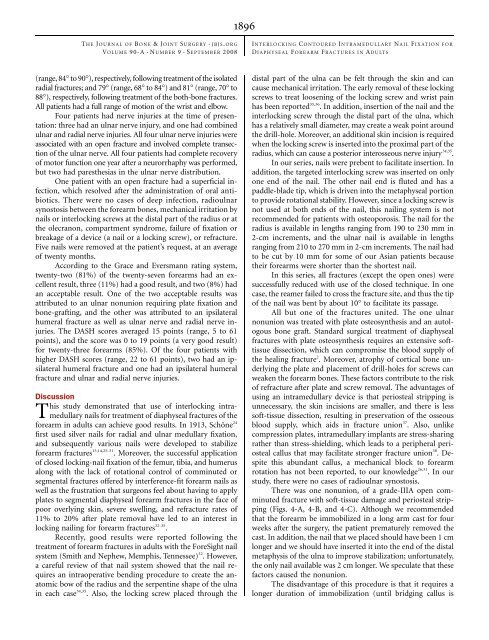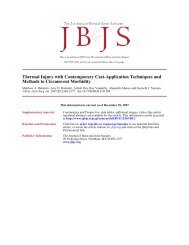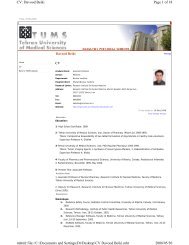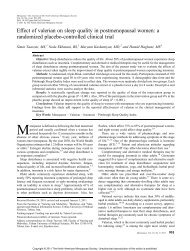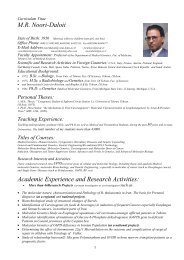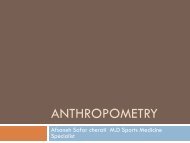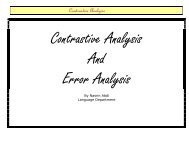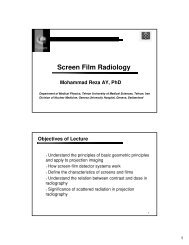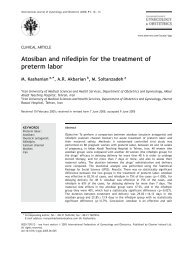Interlocking Contoured Intramedullary Nail Fixation for Selected ...
Interlocking Contoured Intramedullary Nail Fixation for Selected ...
Interlocking Contoured Intramedullary Nail Fixation for Selected ...
Create successful ePaper yourself
Turn your PDF publications into a flip-book with our unique Google optimized e-Paper software.
d THE J OURNAL OF B ONE &JOINT S URGERY JBJS. ORG<br />
d d VOLUME 90-A N UMBER 9 S EPTEMBER 2008<br />
(range, 84° to 90°), respectively, following treatment of the isolated<br />
radial fractures; and 79° (range, 68° to 84°)and81° (range, 70° to<br />
88°), respectively, following treatment of the both-bone fractures.<br />
All patients had a full range of motion of the wrist and elbow.<br />
Four patients had nerve injuries at the time of presentation:<br />
three had an ulnar nerve injury, and one had combined<br />
ulnar and radial nerve injuries. All four ulnar nerve injuries were<br />
associated with an open fracture and involved complete transection<br />
of the ulnar nerve. All four patients had complete recovery<br />
of motor function one year after a neurorrhaphy was per<strong>for</strong>med,<br />
but two had paresthesias in the ulnar nerve distribution.<br />
One patient with an open fracture had a superficial infection,<br />
which resolved after the administration of oral antibiotics.<br />
There were no cases of deep infection, radioulnar<br />
synostosis between the <strong>for</strong>earm bones, mechanical irritation by<br />
nails or interlocking screws at the distal part of the radius or at<br />
the olecranon, compartment syndrome, failure of fixation or<br />
breakage of a device (a nail or a locking screw), or refracture.<br />
Five nails were removed at the patient’s request, at an average<br />
of twenty months.<br />
According to the Grace and Eversmann rating system,<br />
twenty-two (81%) of the twenty-seven <strong>for</strong>earms had an excellent<br />
result, three (11%) had a good result, and two (8%) had<br />
an acceptable result. One of the two acceptable results was<br />
attributed to an ulnar nonunion requiring plate fixation and<br />
bone-grafting, and the other was attributed to an ipsilateral<br />
humeral fracture as well as ulnar nerve and radial nerve injuries.<br />
The DASH scores averaged 15 points (range, 5 to 61<br />
points), and the score was 0 to 19 points (a very good result)<br />
<strong>for</strong> twenty-three <strong>for</strong>earms (85%). Of the four patients with<br />
higher DASH scores (range, 22 to 61 points), two had an ipsilateral<br />
humeral fracture and one had an ipsilateral humeral<br />
fracture and ulnar and radial nerve injuries.<br />
Discussion<br />
This study demonstrated that use of interlocking intramedullary<br />
nails <strong>for</strong> treatment of diaphyseal fractures of the<br />
<strong>for</strong>earm in adults can achieve good results. In 1913, Schöne 24<br />
first used silver nails <strong>for</strong> radial and ulnar medullary fixation,<br />
and subsequently various nails were developed to stabilize<br />
<strong>for</strong>earm fractures 13,14,25-31 . Moreover, the successful application<br />
of closed locking-nail fixation of the femur, tibia, and humerus<br />
along with the lack of rotational control of comminuted or<br />
segmental fractures offered by interference-fit <strong>for</strong>earm nails as<br />
well as the frustration that surgeons feel about having to apply<br />
plates to segmental diaphyseal <strong>for</strong>earm fractures in the face of<br />
poor overlying skin, severe swelling, and refracture rates of<br />
11% to 20% after plate removal have led to an interest in<br />
locking nailing <strong>for</strong> <strong>for</strong>earm fractures 32-35 .<br />
Recently, good results were reported following the<br />
treatment of <strong>for</strong>earm fractures in adults with the ForeSight nail<br />
system (Smith and Nephew, Memphis, Tennessee) 32 . However,<br />
a careful review of that nail system showed that the nail requires<br />
an intraoperative bending procedure to create the anatomic<br />
bow of the radius and the serpentine shape of the ulna<br />
in each case 34,35 . Also, the locking screw placed through the<br />
1896<br />
INTERLOCKING C ONTOURED I NTRAMEDULLARY NAIL F IXATION FOR<br />
DIAPHYSEAL F OREARM FRACTURES IN A DULTS<br />
distal part of the ulna can be felt through the skin and can<br />
cause mechanical irritation. The early removal of these locking<br />
screws to treat loosening of the locking screw and wrist pain<br />
has been reported 35,36 . In addition, insertion of the nail and the<br />
interlocking screw through the distal part of the ulna, which<br />
has a relatively small diameter, may create a weak point around<br />
the drill-hole. Moreover, an additional skin incision is required<br />
when the locking screw is inserted into the proximal part of the<br />
radius, which can cause a posterior interosseous nerve injury 34,35 .<br />
In our series, nails were prebent to facilitate insertion. In<br />
addition, the targeted interlocking screw was inserted on only<br />
one end of the nail. The other nail end is fluted and has a<br />
paddle-blade tip, which is driven into the metaphyseal portion<br />
to provide rotational stability. However, since a locking screw is<br />
not used at both ends of the nail, this nailing system is not<br />
recommended <strong>for</strong> patients with osteoporosis. The nail <strong>for</strong> the<br />
radius is available in lengths ranging from 190 to 230 mm in<br />
2-cm increments, and the ulnar nail is available in lengths<br />
ranging from 210 to 270 mm in 2-cm increments. The nail had<br />
to be cut by 10 mm <strong>for</strong> some of our Asian patients because<br />
their <strong>for</strong>earms were shorter than the shortest nail.<br />
In this series, all fractures (except the open ones) were<br />
successfully reduced with use of the closed technique. In one<br />
case, the reamer failed to cross the fracture site, and thus the tip<br />
of the nail was bent by about 10° to facilitate its passage.<br />
All but one of the fractures united. The one ulnar<br />
nonunion was treated with plate osteosynthesis and an autologous<br />
bone graft. Standard surgical treatment of diaphyseal<br />
fractures with plate osteosynthesis requires an extensive softtissue<br />
dissection, which can compromise the blood supply of<br />
the healing fracture 2 . Moreover, atrophy of cortical bone underlying<br />
the plate and placement of drill-holes <strong>for</strong> screws can<br />
weaken the <strong>for</strong>earm bones. These factors contribute to the risk<br />
of refracture after plate and screw removal. The advantages of<br />
using an intramedullary device is that periosteal stripping is<br />
unnecessary, the skin incisions are smaller, and there is less<br />
soft-tissue dissection, resulting in preservation of the osseous<br />
blood supply, which aids in fracture union 37 . Also, unlike<br />
compression plates, intramedullary implants are stress-sharing<br />
rather than stress-shielding, which leads to a peripheral periosteal<br />
callus that may facilitate stronger fracture union 38 . Despite<br />
this abundant callus, a mechanical block to <strong>for</strong>earm<br />
rotation has not been reported, to our knowledge 26,31 . In our<br />
study, there were no cases of radioulnar synostosis.<br />
There was one nonunion, of a grade-IIIA open comminuted<br />
fracture with soft-tissue damage and periosteal stripping<br />
(Figs. 4-A, 4-B, and 4-C). Although we recommended<br />
that the <strong>for</strong>earm be immobilized in a long arm cast <strong>for</strong> four<br />
weeks after the surgery, the patient prematurely removed the<br />
cast. In addition, the nail that we placed should have been 1 cm<br />
longer and we should have inserted it into the end of the distal<br />
metaphysis of the ulna to improve stabilization; un<strong>for</strong>tunately,<br />
the only nail available was 2 cm longer. We speculate that these<br />
factors caused the nonunion.<br />
The disadvantage of this procedure is that it requires a<br />
longer duration of immobilization (until bridging callus is


